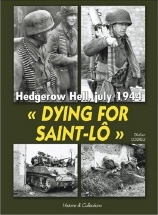Dying for Saint-Lo – Book Review
 Dying for Saint-Lo: Hedgerow Hell, July 1944. By Didier Lodieu. Translated from the French by Alan McKay & Philippe Charbonnier. Publisher: Histoire & Collections (31 Oct 2007). Hardcover: 176 pages. £21.00.
Dying for Saint-Lo: Hedgerow Hell, July 1944. By Didier Lodieu. Translated from the French by Alan McKay & Philippe Charbonnier. Publisher: Histoire & Collections (31 Oct 2007). Hardcover: 176 pages. £21.00.
St Lo was essential for the Germans to hold and for the U.S. to take
“Ten minutes later, one of the tanks was destroyed in close combat by the bazooka team. Shortly afterwards the team re-emerged on the flanks of the two other tanks after getting through a hedge and across a lane, disorienting the Panzerschutz who lost another tank. In a flash the two GIs changed positions then attacked the last panzer which they also destroyed.”
{default}
This book covers the hedgerow-to-hedgerow battle in front of St-Lo between German and U.S. forces in Normandy during the period of July 7 – 21, 1944. It is broken into day-by-day accounts of each major section of the battlefield, covering the attacks of the US 2nd, 9th, 29th, 30th, and 35th Infantry divisions and the 3rd Armored Division and, on the German side, Panzer Lehr, 3rd Fallschirmjager Division, 352nd and 353rd Infantry divisions. St Lo, located in the Manche department in the heart of the bocage, was essential for the Germans to hold and for the U.S. to take; it would help set the stage for the Allied breakout that would shortly follow. The U.S. forces would suffer over 12,000 losses; the Germans would lose thousands of crack troops including pioneers, paratroopers and SS panzer grenadiers in this battle of attrition known as "Hedgrow Hell."
The author covers a lot of the small unit actions typical of the fighting in the hedgerows, using first person accounts, diaries and photos taken during and after the combat.
"The platoon got together in a sunken lane and marched back to our old positions which we manned again. The whole sector was being shelled and watched carefully by American pilots who strafed us whenever they could. In the positions we found bodies of our own troops, killed by the enemy fighters’ dive-bombing attacks.”
Physically, the book is well constructed. It is an over-sized, hardbound book with glossy, heavy-weight paper. It features more than 200 black-and-white photos, full-color situation maps, and OBs of the participating forces. The narrative was drawn from historical records, unit reports and personal diaries of the participants and witnesses. The translation and editing into English suffers a little but on the whole it is readily understandable and well written. The photos alone make it worth the purchase price.
ACG Intel


0 Comments
Trackbacks/Pingbacks